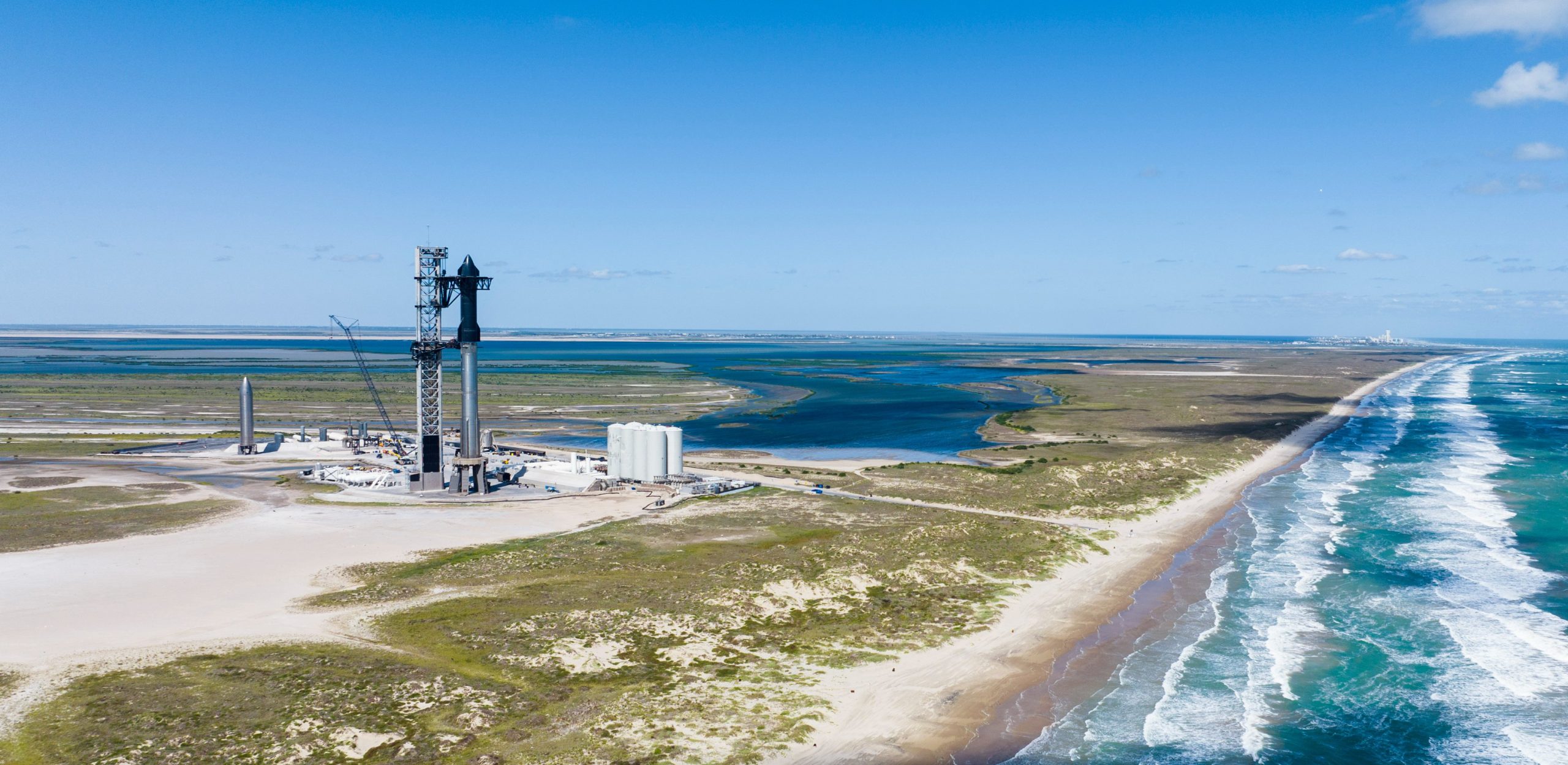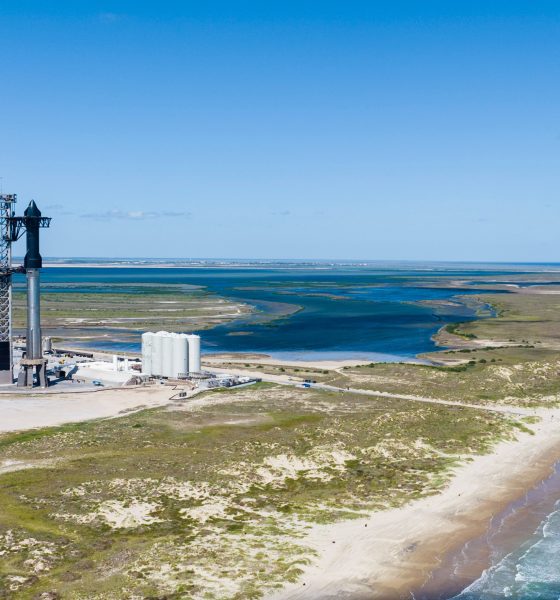

News
SpaceX Starship Integrated Flight Test 2: What to Expect
After a one-day delay to replace a failed grid fin actuator, SpaceX is now less than 24 hours from the second test flight of Starship. SpaceX will have a 20-minute launch window that opens at 7:00 AM CT (13:00 UTC).
Making this test flight is Ship 25 and Booster 9. Ship 25 is powered by 6 Raptor engines (3 sea level and 3 vacuum), and Booster 9 is powered by 33 Raptor engines.
Booster 9 features many upgrades over the last booster to take flight, including better engine shielding and a switch from hydraulic thrust vector controls to electric TVC. Ship 25 didn’t see as many upgrades as the booster, and not much has been shared of any major changes that were made. One change to both vehicles was the improvement of the Flight Termination System, which took much longer to destroy the rocket than expected during the first test.
Launch Day
T minus 2 hours before the scheduled liftoff, the SpaceX launch director will give the go for propellant loading. This process will begin at t minus 1 hour and 37 minutes, and at this point, Booster 9 will begin loading with both liquid oxygen and liquid methane.
T minus 1 hour and 17 minutes, liquid methane will begin loading onto Ship 25, followed by liquid oxygen 4 minutes later at t minus 1 hour and 13 minutes.
T minus 19 minutes and 40 seconds, the 39 Raptor engines on Booster 9 and Ship 25 will begin chilling to prepare for the extremely cold fuel to flow through and prevent thermal shock to engine hardware.
T minus 10 seconds, the flame deflector installed after the first IFT will begin flowing water.
Super Heavy Booster 9 static fire successfully lit all 33 Raptor engines, with all but two running for the full duration. Congratulations to the SpaceX team on this exciting milestone! pic.twitter.com/1hzs768vHg
— SpaceX (@SpaceX) August 25, 2023
T minus 3 seconds, Raptor engine ignition begins, and thrust begins to build to allow for liftoff.
LIFT OFF!
T+ 2 seconds, the 2nd Integrated Flight Test should now be officially underway, with Booster 9 thundering away from the orbital launch mount.
Liftoff from Starbase pic.twitter.com/rgpc2XO7Z9
— SpaceX (@SpaceX) April 20, 2023
T+ 52 seconds, Starship and Booster 9 reach Max Q, the area of maximum dynamic pressure on the vehicle will occur here. If (or most) all Raptor engines on Booster 9 are performing nominally, the vehicle will pass through this fairly quickly.
T+ 2 minutes and 39 seconds, Staging. This will be the first time SpaceX has ever attempted hot staging. Almost all of Booster 9 engines will cut out, and Ship 25 will ignite its Raptor engines to separate from the booster. This is all unknown territory from this point on for SpaceX, as the first test flight did not make it this far. SpaceX has yet to clarify how many Ship 25 engines will ignite during this process.
If all goes well, Booster 9 will begin its flip and boost backburn at t+ 2 minutes and 53 seconds, which will last ~54 seconds. Unlike the Falcon 9, the booster is not designed to perform an entry burn.
T+ 6 minutes and 30 seconds after lift-off, Booster 9 will begin its landing burn for a hopeful soft touchdown in the Gulf of Mexico 18 seconds after landing burn ignition. The planned landing area is ~20 miles (32 km) downrange.
Meanwhile, Ship 25 will continue burning its 6 Raptor engines until t+ 8 minutes and 33 seconds, inserted into a sub-orbital trajectory, and then enter a coast phase until its planned reentry North of the Hawaiian islands.
Landing!
At t+ 1 hour and 17 minutes, Starship will begin feeling the effects of the atmosphere, its first real test for the heatshield. If it survives atmospheric entry, Starship will splash down in the Pacific Ocean at t+ 1 hour and 30 minutes after lift off. SpaceX has said Ship 25 will not attempt a landing burn during this test.
If Starship is able to make it past staging, SpaceX will most likely consider this test a success, but it would be a major accomplishment for Ship 25 to survive entry back through the atmosphere and gather important data for the company.
If you have a chance to make it to South Texas or even the other side of the Rio Grande in Mexico, it’ll be a sight you’ll never forget. If you’re watching from home, SpaceX will begin streaming the launch on X and their website 35 minutes before lift-off.
Questions or comments? Shoot me an email at rangle@teslarati.com, or Tweet me @RDAnglePhoto.

News
Tesla FSD fleet is nearing 7 billion total miles, including 2.5 billion city miles
As can be seen on Tesla’s official FSD webpage, vehicles equipped with the system have now navigated over 6.99 billion miles.

Tesla’s Full Self-Driving (Supervised) fleet is closing in on almost 7 billion total miles driven, as per data posted by the company on its official FSD webpage.
These figures hint at the massive scale of data fueling Tesla’s rapid FSD improvements, which have been quite notable as of late.
FSD mileage milestones
As can be seen on Tesla’s official FSD webpage, vehicles equipped with the system have now navigated over 6.99 billion miles. Tesla owner and avid FSD tester Whole Mars Catalog also shared a screenshot indicating that from the nearly 7 billion miles traveled by the FSD fleet, more than 2.5 billion miles were driven inside cities.
City miles are particularly valuable for complex urban scenarios like unprotected turns, pedestrian interactions, and traffic lights. This is also the difference-maker for FSD, as only complex solutions, such as Waymo’s self-driving taxis, operate similarly on inner-city streets. And even then, incidents such as the San Francisco blackouts have proven challenging for sensor-rich vehicles like Waymos.
Tesla’s data edge
Tesla has a number of advantages in the autonomous vehicle sector, one of which is the size of its fleet and the number of vehicles training FSD on real-world roads. Tesla’s nearly 7 billion FSD miles then allow the company to roll out updates that make its vehicles behave like they are being driven by experienced drivers, even if they are operating on their own.
So notable are Tesla’s improvements to FSD that NVIDIA Director of Robotics Jim Fan, after experiencing FSD v14, noted that the system is the first AI that passes what he described as a “Physical Turing Test.”
“Despite knowing exactly how robot learning works, I still find it magical watching the steering wheel turn by itself. First it feels surreal, next it becomes routine. Then, like the smartphone, taking it away actively hurts. This is how humanity gets rewired and glued to god-like technologies,” Fan wrote in a post on X.
News
Tesla starts showing how FSD will change lives in Europe
Local officials tested the system on narrow country roads and were impressed by FSD’s smooth, human-like driving, with some calling the service a game-changer for everyday life in areas that are far from urban centers.

Tesla has launched Europe’s first public shuttle service using Full Self-Driving (Supervised) in the rural Eifelkreis Bitburg-Prüm region of Germany, demonstrating how the technology can restore independence and mobility for people who struggle with limited transport options.
Local officials tested the system on narrow country roads and were impressed by FSD’s smooth, human-like driving, with some calling the service a game-changer for everyday life in areas that are far from urban centers.
Officials see real impact on rural residents
Arzfeld Mayor Johannes Kuhl and District Administrator Andreas Kruppert personally tested the Tesla shuttle service. This allowed them to see just how well FSD navigated winding lanes and rural roads confidently. Kruppert said, “Autonomous driving sounds like science fiction to many, but we simply see here that it works totally well in rural regions too.” Kuhl, for his part, also noted that FSD “feels like a very experienced driver.”
The pilot complements the area’s “Citizen Bus” program, which provides on-demand rides for elderly residents who can no longer drive themselves. Tesla Europe shared a video of a demonstration of the service, highlighting how FSD gives people their freedom back, even in places where public transport is not as prevalent.
What the Ministry for Economic Affairs and Transport says
Rhineland-Palatinate’s Minister Daniela Schmitt supported the project, praising the collaboration that made this “first of its kind in Europe” possible. As per the ministry, the rural rollout for the service shows FSD’s potential beyond major cities, and it delivers tangible benefits like grocery runs, doctor visits, and social connections for isolated residents.
“Reliable and flexible mobility is especially vital in rural areas. With the launch of a shuttle service using self-driving vehicles (FSD supervised) by Tesla in the Eifelkreis Bitburg-Prüm, an innovative pilot project is now getting underway that complements local community bus services. It is the first project of its kind in Europe.
“The result is a real gain for rural mobility: greater accessibility, more flexibility and tangible benefits for everyday life. A strong signal for innovation, cooperation and future-oriented mobility beyond urban centers,” the ministry wrote in a LinkedIn post.
News
Tesla China quietly posts Robotaxi-related job listing
Tesla China is currently seeking a Low Voltage Electrical Engineer to work on circuit board design for the company’s autonomous vehicles.

Tesla has posted a new job listing in Shanghai explicitly tied to its Robotaxi program, fueling speculation that the company is preparing to launch its dedicated autonomous ride-hailing service in China.
As noted in the listing, Tesla China is currently seeking a Low Voltage Electrical Engineer to work on circuit board design for the company’s autonomous vehicles.
Robotaxi-specific role
The listing, which was shared on social media platform X by industry watcher @tslaming, suggested that Tesla China is looking to fill the role urgently. The job listing itself specifically mentions that the person hired for the role will be working on the Low Voltage Hardware team, which would design the circuit boards that would serve as the nervous system of the Robotaxi.
Key tasks for the role, as indicated in the job listing, include collaboration with PCB layout, firmware, mechanical, program management, and validation teams, among other responsibilities. The role is based in Shanghai.
China Robotaxi launch
China represents a massive potential market for robotaxis, with its dense urban centers and supportive policies in select cities. Tesla has limited permission to roll out FSD in the country, though despite this, its vehicles have been hailed as among the best in the market when it comes to autonomous features. So far, at least, it appears that China supports Tesla’s FSD and Robotaxi rollout.
This was hinted at in November, when Tesla brought the Cybercab to the 8th China International Import Expo (CIIE) in Shanghai, marking the first time that the autonomous two-seater was brought to the Asia-Pacific region. The vehicle, despite not having a release date in China, received a significant amount of interest among the event’s attendees.








